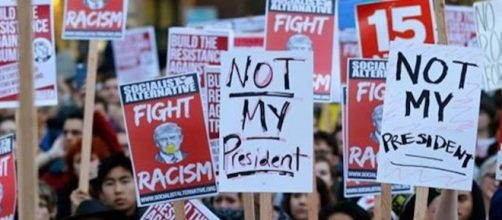On the national holiday of President's Day, protesters decided to resist their current president. According to USA Today and NBC, thousands of citizens gathered in rallies across the country to chant "Not My President," "The people united will never be divided," and many more anti-trump, pro-inclusion statements. They were referred to as the "Not My President's Day" protests. I could not be more excited and inspired to see such mass political activism and freedom. I could not be more proud to be American to see my peers standing up for what they believe in for their country.
The resistance persists
Trump protests began and grew rapidly throughout the presidential election as it became more apparent that he was being seriously considered for the president. Public opinion fluctuated as the rallies got criticism about being ineffective, entitled and even childish. Some protests devolved into riots. Articles, such as one from US News, questioned whether it could survive in such a quickly-changing era. Would people lose interest when the next thing came along? Many Trump supporters do use the few riots there have been to say the movement is unproductive and negative. However, there have been many more inclusive and peaceful events. Though there is still doubt, protests on President's Day send a message: we're here, we're serious and we will fight.
Determination seems to be ever-rising for protesters to challenge the Trump administration. Having attended many of these rallies, the power and energy are tangible.
An engaged generation
Being part of the generation myself, I could see some validity to the criticism that Millennials were not involved enough in politics. In general, young people have often been absent from polling places and political events.
However, I believe this past election has dramatically changed that. It started with the inspiring and uplifting rhetoric of Bernie Sanders. The fervor continued when Clinton won the DNC nomination and many felt cheated by the Democratic Party. It reached a climax when Trump began to gain popularity and exploded when he won.
Suddenly, it seemed, Millennials were more politically active than ever. Many, myself included, joined many nonprofits, started donating, writing emails and calling representatives, signing and sharing petitions and exercising rights to peaceful protest. We started paying attention because we know we are the future. And we don't like what we're seeing of it.
Trump plays it cool, Spicer claims paid protesters
When the Women's March across the United States drew over a million citizens together against him the day after inauguration, and those in other countries as well, Trump wrote it off. He denied that there were as many protesters as there were. However, White House contacts reported that he was distraught over the resistance.
For someone as concerned with reputation and crowd sizes as Trump is, it's not surprising. He does not seem to be able to take criticism. Spicer, alternatively, has made several public statements that he believes the protesters are paid and planted, echoing a sentiment within the White House. If that's true, I wonder where my money is.
Protesters it for the long haul
Through the criticism from the White House and the "snowflake" comments from Trump supporters, the Resistance has thrived. Looking at photos and videos of these rallies, I see the drive, the signs and the sheer human power to make a statement. The events themselves may not seem very effective, particularly in areas that voted blue, but they receive news coverage, are spread through social media like Facebook, Twitter, and Snapchat and collaborate with calls to representatives, politicians, petitions and donations.
It appears that this movement will not simply fade into irrelevance. Every day that Trump shows he does not have the interests of Americans above his own and that he will not stand by women, Muslims, minorities and immigrants give reason to fight harder.

